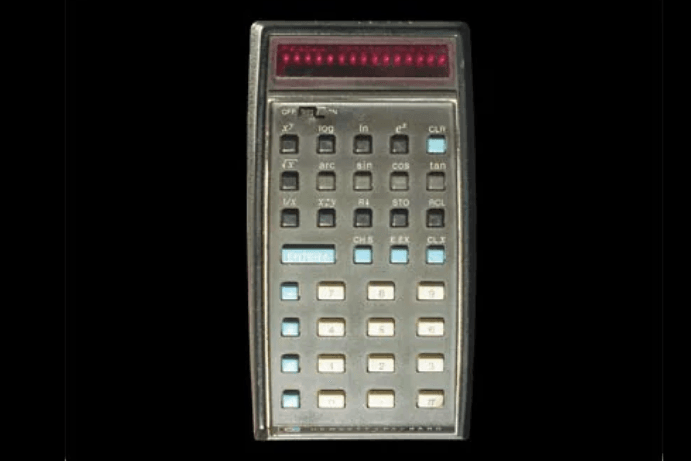HP-35 by Hewlett-Packard
On February 1, 1972, Hewlett-Packard (HP) introduced the HP-35. It was a revolutionary moment in the world of technology and mathematics. Till then scientific calculators were typically large in size and used primarily by academicians and research fellows in labs.
HP changed all that. It introduced the concept of portability and launched the then-world’s first hand-held calculator capable of performing scientific calculations with ease. This scientific calculator consists of 35 keys. It was also the first product advertised by HP directly to consumers.
The HP-35 was built around a revolutionary integrated circuit (IC) and LEDs (light-emitting diodes). Both technologies had been developed in HP Labs. Further, allowed it to perform calculations efficiently while remaining portable. It featured a 10-digit display. This IC-powered LED display was capable of handling functions that were once only possible with large machines used in laboratories.
Beyond its practicality, the HP-35 helped make mathematics and science more approachable for engineering, research, and development students.
Oxford English Dictionary
On February 1, 1884, the first volume of the now “Oxford English Dictionary” (OED) was published. Though, it was originally titled “A New English Dictionary on Historical Principles”. The first part (initial fascicle) consisted of 352 pages covering “a” through “ant”. It sold about 4000 copies. This marked a remarkable achievement and since then, the OED has become one of the most respected and comprehensive dictionaries in the world.
The journey toward the OED began long before its first publication. The earliest English dictionaries were primarily bilingual, serving as glossaries for French, Spanish, or Latin terms with English definitions.
The Oxford English Dictionary was published in installments, with the first complete edition released in 1928, containing ten volumes. In 1933, it was reprinted as twelve volumes with a one-volume supplement. Subsequent supplements were added over the years, leading to the publication of the second edition in 1989, which comprised 21,728 pages across twenty volumes. The last printed edition of the OED was published in 1989 and contained 20 volumes.
For those who dream of traveling in a time machine, Big Moves’ exciting new scientific history series Big Chronicles is here. Buckle up, we will take you on a thrilling ride through the most fascinating moments in history.
Birth and Remarkable Achievements of G. Stanley Hall
Granville Stanley Hall was born on February 1, 1844. He was the first American to earn a doctorate in psychology in the history of psychology. He was awarded the degree in the United States of America at Harvard College in the nineteenth century.
Here are some key contributions of G. Stanley Hall:
- Developmental Psychology: Hall is widely regarded as one of the first psychologists to explore the study of adolescence and its psychological development. He coined the term “adolescence” and was the first to recognize it as a distinct period of life, bridging childhood and adulthood. He explored the psychological changes that take place during this stage.
- First President of the APA: Hall served as the first president of the American Psychological Association (APA) in 1892 and was instrumental in establishing the APA as a significant professional organization.
- Child Psychology: He was frequently regarded as the founder of “Child Psychology.” However, there is no official statement of confirmation has been released by any recognized agency. He conducted some of the earliest studies on child development and established one of the first American laboratories for experimental psychology at Johns Hopkins University.
- Influence on Education: Hall was deeply involved in educational psychology and was an advocate for education reforms. He believed that the development of psychology could help improve teaching methods, and he was instrumental in integrating scientific principles into educational practces.
- Publications and Work: Hall wrote extensively on psychological topics, and his major work, Adolescence (1904), was groundbreaking in its exploration of the emotional and developmental changes during the teenage years.

